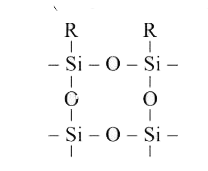On controlled hydrolysis and condensation, R3SiCl yields
R3Si−O−SiR3
(−R3Si−O−SiR3−)n
R3SiOH

To solve the question regarding the controlled hydrolysis and condensation of R3SiCl, we can break down the process step by step.
1. Identify the Reactants:
The reactant is R3SiCl, where R represents an organic group (alkyl or aryl group).
2. Hydrolysis Reaction:
When R3SiCl undergoes hydrolysis, it reacts with water (H2O). The reaction can be represented as:
R3SiCl+H2O→R3Si(OH)+HCl
Here, one molecule of water reacts with R3SiCl to produce R3Si(OH) and hydrochloric acid (HCl).
3. Controlled Hydrolysis:
In controlled hydrolysis, we can assume that we are using two molecules of R3SiCl and two molecules of water:
2R3SiCl+2H2O→2R3Si(OH)+2HCl
4. Condensation Reaction:
The next step involves the condensation of the hydrolyzed product R3Si(OH). When two R3Si(OH) molecules condense, they release water and form a siloxane bond:
R3Si(OH)+R3Si(OH)→R3SiOSiR3+H2O
This results in the formation of a siloxane compound R3SiOSiR3 and water.
5. Final Product:
The final product after controlled hydrolysis and condensation of R3SiCl is:
R3SiOSiR3
Conclusion:
The answer to the question is that on controlled hydrolysis and condensation, R3SiCl yields R3SiOSiR3.
The reactant is R3SiCl, where R represents an organic group (alkyl or aryl group).
When R3SiCl undergoes hydrolysis, it reacts with water (H2O). The reaction can be represented as:
R3SiCl+H2O→R3Si(OH)+HCl
Here, one molecule of water reacts with R3SiCl to produce R3Si(OH) and hydrochloric acid (HCl).
In controlled hydrolysis, we can assume that we are using two molecules of R3SiCl and two molecules of water:
2R3SiCl+2H2O→2R3Si(OH)+2HCl
The next step involves the condensation of the hydrolyzed product R3Si(OH). When two R3Si(OH) molecules condense, they release water and form a siloxane bond:
R3Si(OH)+R3Si(OH)→R3SiOSiR3+H2O
This results in the formation of a siloxane compound R3SiOSiR3 and water.
The final product after controlled hydrolysis and condensation of R3SiCl is:
R3SiOSiR3
The answer to the question is that on controlled hydrolysis and condensation, R3SiCl yields R3SiOSiR3.
Topper's Solved these Questions
- p-BLOCK ELEMENTS-1BOOK - VMC MODULES ENGLISHCHAPTER - p-BLOCK ELEMENTS-1EXERCISE - LEVEL 2
73 Videos
- p-BLOCK ELEMENTS-1BOOK - VMC MODULES ENGLISHCHAPTER - p-BLOCK ELEMENTS-1EXERCISE - JEE Main Archive
34 Videos
- p-BLOCK ELEMENTS-1BOOK - VMC MODULES ENGLISHCHAPTER - p-BLOCK ELEMENTS-1EXERCISE - JEE Advanced Archive
48 Videos
- MOCK TEST 9BOOK - VMC MODULES ENGLISHCHAPTER - MOCK TEST 9EXERCISE - CHEMISTRY (SECTION 2)
5 Videos
- PERIODIC PROPERTIES OF ELEMENTSBOOK - VMC MODULES ENGLISHCHAPTER - PERIODIC PROPERTIES OF ELEMENTSEXERCISE - IMPECCABLE
50 Videos
Similar Questions
Alkyl substituted chlorosilane, RnSiCl(4−n), on hydrolysis and then condensation polymerisation yield silicones What is the value of n is the alkyl substituted chlorosilane used for the preparation of cross linked silicone.
View SolutionThe role of addition of Me3SiCl during the hydrolysis followed by conduction of Me2SiCl2 is.
View SolutionHydrolysis of fat yields
View SolutionBF3 on hydrolysis forms
View SolutionThe hydrolysis of trialkylchlorosilane , R3SiCl, yields ……………………..,
View SolutionBe2C on hydrolysis yields
View SolutionMg3P2 on hydrolysis produces
View SolutionOn hydrolysis a nucleoside would not yield
View SolutionHydrolysis of PI3 yield
View SolutionHydrolysis of lactose with dilute acid yields:
View Solution
